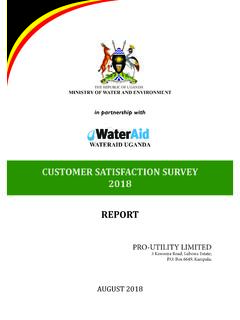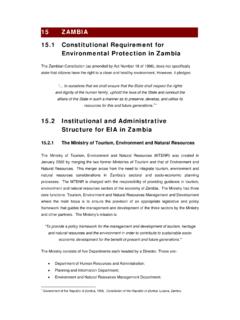Transcription of Ministry of Water and Environment - mwe.go.ug
1 THE REPUBLIC OF UGANDA. Ministry of Water and Environment FRAMEWORK AND GUIDELINES FOR. Water SOURCE PROTECTION. Volume 5: Guidelines for Protecting Water Sources for Hydroelectric Power Plants 5. May 2013. Ministry of Water and Environment REPUBLIC OF UGANDA. Framework and Guidelines for Water Source Protection Volume 5: Guidelines for Protecting Water Sources for Hydroelectric Power Plants Guidelines for Protecting Water Sources for Hydroelectric Power Plants Introduction The Water Sources Protection Guidelines for Hydroelectric power plants describe steps to follow to prepare a Water Source Protection Plan. The description in this Volume is derived from the overall Framework for Water Sources Protection Guidelines (Volume 1).
2 The document emphasises those steps, actions and considerations that are particularly relevant to protecting a Water source for a small to medium sized hydroelectric scheme. The Volume is intended to be a standalone document for ease of its application by those concerned with hydroelectric power plants. However, the user may wish to refer to Volume 1 where appropriate so as to ensure that the guidelines in this Volume are correctly interpreted in context of the overall framework for protecting Water sources. 2. Ministry of Water and Environment REPUBLIC OF UGANDA. Framework and Guidelines for Water Source Protection Volume 5: Guidelines for Protecting Water Sources for Hydroelectric Power Plants Table of Contents Guidelines for Protecting Water Sources for Hydroelectric Power Plants.
3 2. Introduction .. 2. Acknowledgements .. 6. 1 Water Source Protection for Hydroelectric Power Plants .. 7. What is Water Source Protection? .. 7. What are the guidelines for? ..10. Who should use these guidelines?..10. Why and when use these guidelines? ..11. The role of a Regulator in applying the Guidelines ..12. The Role of Implementer ..12. What is hydroelectricity supply being protected from?..12. How long will it take to produce a Water Source Protection Plan? ..12. What skills do I need to have in my team to implement these guidelines? ..13. 2 Guideline Process ..14. Guidelines for NEW Hydroelectric Power Plants ..16. Guidelines for EXISTING Hydroelectric Power Plants.
4 28. 3 Water Source Protection Plan PART A Water Source Description Summary ..40. PART B Aims, Objectives, Targets and Monitoring Summary ..41. PART C Risks and Control Measures Summary ..41. PART D Action Plan PART E Financial Plan Summary ..42. PART F Evidence Base ..42. 4 Water Source Protection Checklist for Regulators ..43. 5 Technical Support Annexes ..44. ANNEX A: Relevant Ugandan Policy, Legislation and Regulations ..44. ANNEX B: Basic Water Balance Estimation Method ..44. ANNEX C: Hazard Types ..45. ANNEX D: Generic Threats for Hydroelectric Power Plants ..46. ANNEX E: Stakeholder Record Sheet ..47. ANNEX F: Livelihood Analysis Template.
5 48. ANNEX G: Ideas for Targets and Indicators ..48. ANNEX H: Generic Control Measures ..49. ANNEX I: Directory of Control Measure Specialists (Step ) ..51. ANNEX J: Further Information ..52. ANNEX M: Organisational Mandates ..54. 3. Ministry of Water and Environment REPUBLIC OF UGANDA. Framework and Guidelines for Water Source Protection Volume 5: Guidelines for Protecting Water Sources for Hydroelectric Power Plants List of Tables Table 1: Over-arching objectives for Water Source Table 2: User groups for Water Source Protection Guidelines ..11. List of Figures Figure 1: Water Cycle .. 7. Figure 2: Common elements of Hydroelectric Power Plants.
6 8. Figure 3: A catchment area (river example) .. 8. Figure 4: Threat-Pathway- Water Source model elements .. 9. Figure 5: The Guideline Steps ..14. Acronyms CBO Community Based Organisation CLTS Community-Led Total Sanitation CMO Catchment Management Organisation DEA Directorate of Environmental Affairs DIM District Implementation Manual DWD Directorate of Water Development DWO District Water Officers DWRM Directorate of Water Resource Management EIA Environmental Impact Assessment FSSD Forestry Sector Support Department iNGO International Non Governmental Organisation IUCN International Union for the Conservation of Nature JAF Joint Assessment Framework JSR Joint Sector Review MoAAIF Ministry of Agriculture.
7 Animal Industry and Fisheries MoEMD Ministry of Energy and Mineral Development MoFPED Ministry of Finance, Planning and Economic Development MoLHUD Ministry of Lands, Housing and Urban Development MWE Ministry of Water & Environment NEMA National Environmental Management Authority NFA National Forest Authority NGO Non-Governmental Organisation NWSC National Water and Sewerage Corporation OPM Office of the Prime Minister T/P/WS Threat-Pathway- Water Source model TSU Technical Support Unit UWA Uganda Wildlife Authority WMZ Water Management Zones WRM Water Resources Management WSDF Water and Sanitation Development Facility WSPC Water Source Protection Committee WSPP Water Source Protection Plan 4.
8 Ministry of Water and Environment REPUBLIC OF UGANDA. Framework and Guidelines for Water Source Protection Volume 5: Guidelines for Protecting Water Sources for Hydroelectric Power Plants Glossary Water Source For the purpose of these guidelines, a Water Source is a geographical point, or piece of infrastructure, where Water is taken from the Environment and used for a specific socio-economic purpose, such as Water supply, agriculture or hydroelectricity generation. Abstraction Taking Water from the Environment , generally by motorised or manual pumping from a well, borehole, lake, river or spring. Aquifer Any body of Water -bearing rock that is sufficiently porous and permeable that Water can be taken, often from natural springs or from artificially drilled or dug wells or boreholes.
9 Contributor A stakeholder that contributes to the development or implementation of a Water Source Protection Plan through facilitation, information sharing, financial or in-kind contributions. Catchment/ Watershed A drainage basin or area of land from which surface Water drains to a single / River Basin exit point (usually a point on a river or the estuary where a river enters the sea). Where there is groundwater, the movement of Water is generally more complex because groundwater drainage does not always follow the same pattern as the overlying topography. In this report Catchment' is used by preference but some the literature refers to watersheds' or river basins', which usually have the same meaning.
10 Control Measure Actions that can be taken to protect a Water Source. Hazard The nature of problem arising from the Threat that can harm the Water Source. Implementer The organisation that is the primary user of these guidelines to prepare a Water Source Protection Plan. For new schemes this will be the developer organisation, for existing schemes it is likely to be the owner of an asset (for example a Water Authority who owns a pumping station or a power company that owns an hydro-electric scheme), or a proxy (for example a Water User Committee who manages a multi-purpose reservoir although ownership lies ultimately with MWE). Pathway The physical route through the Environment by which a Threat affects a Water Source.










